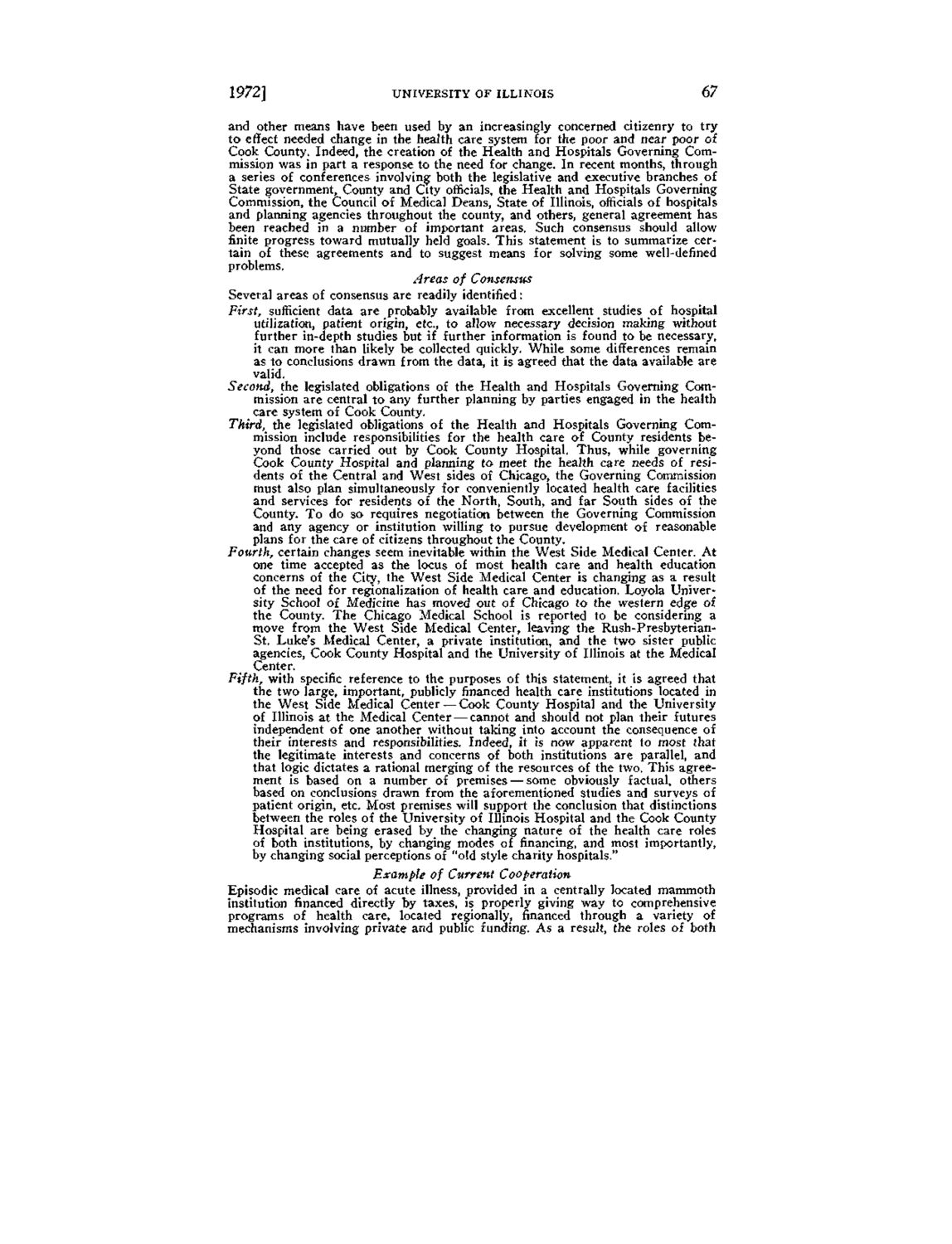| |
| |
Caption: Board of Trustees Minutes - 1974
This is a reduced-resolution page image for fast online browsing.

EXTRACTED TEXT FROM PAGE:
1972] UNIVERSITY OF ILLINOIS 67 and other means have been used by an increasingly concerned citizenry to try to effect needed change in the health care system for the poor and near poor of Cook County. Indeed, the creation of the Health and Hospitals Governing Commission was in part a response to the need for change. In recent months, through a series of conferences involving both the legislative and executive branchesof State government. County and City officials, the Health and Hospitals Governing Commission, the Council of Medical Deans, State of Illinois, officials of hospitals and planning agencies throughout the county, and others, general agreement has been reached in a number of important areas. Such consensus should allow finite progress toward mutually held goals. This statement is to summarize certain of these agreements and to suggest means for solving some well-defined problems. Areas of Consensus Several areas of consensus are readily identified: First, sufficient data are probably available from excellent _ studies of hospital utilization, patient origin, etc., to allow necessary decision making without further in-depth studies but if further information is found to be necessary, it can more than likely be collected quickly. While some differences remain as to conclusions drawn from the data, it is agreed diat the data available are valid. Second, the legislated obligations of the Health and Hospitals Governing Commission are central to any further planning by parties engaged in the health _ care system of Cook County. Third,^ the legislated obligations of the Health and Hospitals Governing Commission include responsibilities for the health care of County residents beyond those carried out by Cook County Hospital. Thus, while governing Cook County Hospital and planning to meet the health care needs of residents of the Central and West sides of Chicago, the Governing Commission must also plan simultaneously for conveniently located health care facilities and services for residents of the North, South, and far South sides of the County. To do so requires negotiation between the Governing Commission and any agency or institution willing to pursue development of reasonable plans for the care of citizens throughout the County. Fourth, certain changes seem inevitable within the West Side Medical Center. At one time accepted as the locus of most health care and health education concerns of the City, the West Side Medical Center is changing as a result of the need for regionalization of health care and education. Loyola University School of Medicine has moved out of Chicago to the western edge of the County. The Chicago Medical School is reported to be considering a move from the West Side Medical Center, leaving the Rush-PresbyterianSt, Luke's Medical Center, a private institution, and the two sister public agencies, Cook County Hospital and the University of Illinois at the Medical Center. Fifth, with specific reference to the purposes of this statement, it is agreed that the two large, important, publicly financed health care institutions located in the West Side Medical Center — Cook County Hospital and the University of Illinois at the Medical Center — cannot and should not plan their futures independent of one another without taking into account the consequence of their interests and responsibilities. Indeed, it is now apparent to most that the legitimate interests and concerns of both institutions are parallel, and that logic dictates a rational merging of the resources of the two. This agreement is based on a number of premises — some obviously factual, others based on conclusions drawn from the aforementioned studies and surveys of patient origin, etc. Most premises will support the conclusion that distinctions between the roles of the University of Illinois Hospital and the Cook County Hospital are being erased by_ the changing nature of the health care roles of both institutions, by changing modes of financing, and most importantly, by changing social perceptions of "old style charity hospitals." Example of Current Cooperation Episodic medical care of acute illness, provided in a centrally located mammoth Institution financed directly by taxes, is properly giving way to comprehensive programs of health care, located regionally, financed through a variety of mechanisms involving private and public funding. As a result, the roles of both
| |